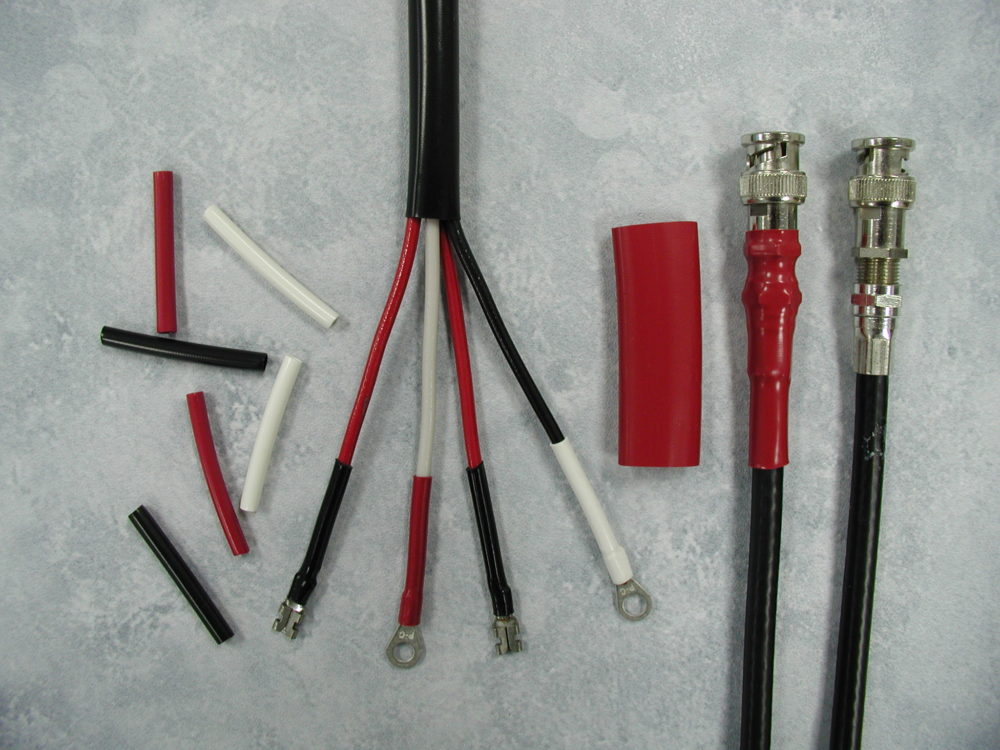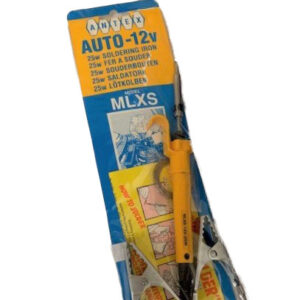
Heat shrink tubing – sometimes referred to as electrical shrink tubing – protects and organizes wiring within electrical arrays. It’s primarily used to prevent damage to electrical components, protecting against hazards like abrasion, dust and moisture, all of which can damage wiring and cause electrical shorts and failures. Use of color-coded heat shrink tubing makes managing components and where wires lead easier to identify as well. Loose wiring, terminals, splices and connectors can also be easily organized to create more manageable bundles with heat shrink tubing. Tips and tricks on its uses, best materials to use and installation is something both DIYers and professional electricians can appreciate.
What is Heat Shrink Tubing and How is It Made?
Heat shrink tubing is made from various thermoplastics, which by their nature shrink when heated. The tubing wraps around electrical components and wire arrays when heat is applied, fitting to contours and creating a protective covering. It can be used for wire bundles, or just individual ones, as a means to protect and organize them.
When applied, the thermoplastic tube goes around wiring and other components. The tubing is then heated to a specific temperature, which causes the plastic to soften and shrink to its original size. This encloses the wire arrays and other components within a tightly wrapped protective layer of plastic.
Plastic manufacturers utilize extrusion to fabricate thermoplastic material into tubes. Once extruded, this material is heated so that it expands and increases in diameter. The expanded material cools to room temperature, where it sets to become heat shrink tubing. Tips and tricks for how to use this tubing and what material works best for it largely depends on how it’s used and the conditions it faces.
Tips and Tricks for Protecting Wiring with Heat Shrink Tubing
As a practical tool, professionals or amateurs performing electrical work can do a lot with heat shrink tubing. Tips and tricks concerning these thermoplastic tubes can help prevent short circuits and damage to cables and wires, while also organizing them. Certain types are even solderable or waterproof. While easy to use, it’s still important to understand a few basics about heat shrink tubing.
Heat Shrink Tubing: Tips and Tricks on How to Use It
Its properties make it well-suited for many uses. Though most deal with wiring or cabling, heat shrink tubing can also be used to wrap other items.
Uses for heat shrink tubing include:
- Bundling wiring or cabling: For electrical systems with many wires or cables, it helps to bundle them together; heat shrink tubing additionally provides a more compact solution than tie wraps.
- Color coding: Most thermoplastics can be colored to allow the easy identification of specific wires or wire bundles, providing another means to organize wiring.
- Electrical insulation: One of the primary purposes for heat shrink tubing is to form a non-conductive protective layer around wiring, terminals, splices and solder joints to insulate and protect them from short-circuiting.
- Environmental protection: Though it doesn’t prevent mechanical damage, heat shrink tubing safeguards wiring against liquids as well as prevents damage from dust or other particulates.
- Preventing damage: It creates a barrier that physically protects against abrasions for not just wiring, but connectors, soldered joints and other electrical elements.
- Reducing strain: Tubing is often applied to more fragile wiring that’s moved frequently like those used to charge phones, in order to relieve mechanical stress that can lead to breakage; by applying heat shrink tubing in places where a wire typically bends, it extends the lifespan of wiring.
- Repairing wiring: Wires with damaged insulation and where copper is exposed can easily be covered with heat shrink tubing.
Heat Shrink Tubing: Tips and Tricks on Using the Best Material for the Application
Along with its multiple uses, many different types of thermoplastic materials can be made into heat shrink tubing. Tips and tricks for working with each material depend on each one’s properties. Understanding these differences can help in choosing the best material for the application.
Heat shrink tubing usually is made from one of these two materials:
- Polyolefin: The most popular material out of which heat shrink tubing is made, it withstands temperatures as high as 275°F (135°C). Durable and flexible, polyolefin also shrinks quickly, along with being highly retardant to flames. It’s generally not a good material to use outdoors, however, as certain pigments degrade in sunlight, though black polyolefin withstands ultraviolet light well.
- Polyvinyl chloride (PVC): Cheaper than polyolefin, PVC works best for those on a budget, though it doesn’t deal well with high temperatures; typically, PVC should only be used up to a 221°F (105°C) maximum temperature. It’s also fairly easy to dye.
Less common materials used to make heat shrink tubing include:
- Elastomers: These rubber-like polymers are flexible even at temperatures as low as -103°F (-75°C). They’re abrasion-resistant and handle diesel fuel, hydraulic fluid and other petroleum-based fuels well.
- Fluorinated ethylene propylene (FEP): Resistant to chemicals and capable of shrinking at lower temperatures, this material is often used for similar applications as PTFE, though it’s a bit less expensive.
- Polytetrafluoroethylene (PTFE): Also known by its brand name, Teflon, PTFE doesn’t react to and resists chemicals. PTFE also handles a wide temperature range, from -67 to 347° F (-55 to 175°C). With a low friction coefficient, it’s very slick.
- Polyvinylidene fluoride (PVDF): Resistant to flames and high temperatures, PVDF’s properties also help it resist corrosive chemicals, perforation and various fuels.
- Silicone: Offering both flexibility and resistance to temperature extremes, silicone is preferred for insulating medical devices as it handles a variety of sterilization techniques well.
- Viton™: A fluoropolymer elastomer, this rubber-like compound is known by its trademark and is used in extremely harsh environments. Able to withstand toxic chemicals and extreme temperatures, it’s a durable material used widely to protect wiring in hydraulic equipment, as it also creates a seal against liquids.
Specialty Types of Heat Shrink Tubing
There are applications that utilize certain types of specially-made heat shrink tubing. Tips and tricks for which to use depend on the environmental conditions they must withstand.
Some of the more common types include:
- Adhesive-lined heat shrink tubing is marine-grade tubing with two layers. The outer layer is made from polyolefin and the inner one consists of a layer of meltable adhesive. When the tubing heats, the adhesive melts while the outer layer shrinks, which helps create a watertight seal.
- Heat shrink butt connectors are composed of a layer of heat shrink tubing on the outside, with an inner section that contains solder on the inside. They can quickly and easily seal wiring without soldering, so they work well for applications where soldering tools would have difficulty reaching.
- Clear heat shrink tubing offers a means by which to inspect connections after shrinking, with transparent tubing primarily used in heat shrink butt connectors to allow evaluation of the solder joint. It also offers an aesthetically pleasing look.
Heat Shrink Tubing: Tips and Tricks for Installing
Before installing, it’s important to correctly size heat shrink tubing. There are some relatively simple tips and tricks to determine the correct diameter to use. Choosing tubing that’s smaller than the smallest component, connector or wire is the most important part of the pre-installation process.
This means, for example, that to cover standard 4-gauge wires, with diameters of 5.893 mm (0.232 inch), the tubing must shrink to under that diameter. This means 11 mm diameter tubing with a 2:1 shrink ratio could be used, which would shrink to 5.5 mm (0.217 inch). Or else 17 mm (0.669 inch) tubing with a 3:1 ratio could be used, which would shrink to 5.67 mm (0. 0.223 inch). Heat shrink tubing should fit snugly around any components, connectors or wires after shrinking. Ideally, the unshrunk diameter of the tubing should be at least 20-30 percent larger than the diameter of the largest component being covered. This allows for easier positioning.
Tools for Installing Heat Shrink Tubing
Though the process of installing heat shrink tubing is fairly straightforward, it takes a few different tools. The most common ratio of heat shrink tubing is 2:1, so the diameter necessary for the application should first be calculated. Along with the tubing, to properly install it just takes scissors, a mini-heat gun and a digital caliper.
How to Install Heat Shrink Tubing
To install heat shrink tubing, tips and tricks may differ depending on the application. However, the process is generally easy to do.
Here is the step-by-step process:
- Use calipers to measure the diameter of wire or component to be insulated.
- Calculate the correct size for the heat shrink tubing.
- Measure out enough tubing length for the specific application.
- Enough tubing should be cut to keep bare wire from being exposed, so the length of tubing should overlap on each side of the wire insulation.
- Since heat shrink tubing typically shrinks about 5-15 percent, this must be factored into this measurement.
- Cut heat shrink tubing to suitable length with scissors.
- Slide tubing over wire or component.
- There should be no friction if the tubing diameter has been correctly measured and chosen.
- If there’s difficulty experienced when sliding tubing into place, it’s advisable to use heat shrink tubing that’s one size larger.
- Use a hot air gun to heat and activate tubing.
- Maintain a moderate distance from the tubing, moving it back and forth along its length.
- Rotate piece being insulated so that it’s heated evenly on all sides.
- Process is finished when the whole tube fits tightly without any internal air bubbles.
- Allow tubing to cool.
- Once cooled, it can be bent and positioned into place safely.
Heat Shrink Tubing by M.M. Newman Corporation
The M.M. Newman Corporation supplies two general types of heat shrink tubing, including types that can handle industrial and military applications. Our company provides products that are exceptionally reliable and of high quality, capable of working across a wide range of applications and industries, while also providing the highest level of customer service. We additionally take great pride in our ISO 9001:2015 certification, for which we seek to provide solutions for our customer’s wiring and cabling protection needs.
M.M. Newman supplies the following types of heat shrink tubing:
- PVC heat shrink tubing is highly flexible, forming tightly around wires or components to provide insulation. Resistant to chemicals, fungus, moisture, oils and sunlight, it also has a low shrink temperature of under 200°F (93°C). It also offers excellent mechanical and dielectric protection.
- Flexible polyolefin heat shrink tubing balances chemical, electrical and physical properties, while also offering exceptional resistance to flames. Rated to operate continuously at 275°F (135°C) and at up to 572°F (300°C) for shorter periods, it works well as fire-resistant component packaging or a lightweight harness covering for wires.
To learn more about heat shrink tubing tips and tricks, or information about any of our other products, we invite you to contact us today.


